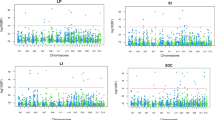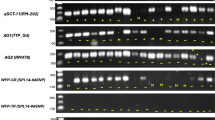Abstract
The effect of 0, 1, 2, 3 and 4 intercross cycles using genetic male sterility on the mean yield and genetic variability of the CNA 5 irrigated rice synthetic population was assessed studying 300 S0:2 (1998/99) and S0:3 (1999/00) families grown in two locations (Lambari, MG and Goianira, GO). Each intercross was investigated using a 8 × 8 triple lattice design experiment containing 60 families and four control cultivars. Five experiments were carried out per location and generation, totaling 20 experiments. Individual, combined over locations, combined over generations and combined over locations and generations analyses of variance were performed. Linear regression equations were fitted to data of each location and generation as well as, genetic and phenotypic parameters were estimated. An average increase of 3.91% in grain yield was obtained with the increase in the number of intercrosses. However, when genetic gains obtained from selection of the five and ten highest yielding families were considered, negative b estimates were always obtained, suggesting a tendency of gain increase reduction with the increase in the number of intercrosses. This was confirmed by the analysis of the means of the best families, since increases in the number of intercrosses did not result in selection of families with greater mean grain yield. The estimates of the genetic variances and heritabilities did not suggest an increase in genetic variability with the increase in intercross cycles. Therefore, carrying out intercrosses on the base population did not improve the results of the irrigated rice recurrent selection program.
Similar content being viewed by others
References
Allard, R.W., 1988. Genetic changes associated with the evolution of adaptedness in cultivated plants and their wild progenitors. J Heredity 79: 225-238.
Altman, D.W. & R.W. Busch, 1984. Random intermating before selection in spring wheat. Crop Sci 24: 1085-1089.
Bajaj, R.K., K.S. Bains, G.S. Chahal & A.S. Khbhra, 1990. Effect of intermating and selection in barley. Crop Improv 17: 54-58.
Barbin, D., 1993. Componentes de variância. Escola Superior de Agricultura 'Luiz de Queiroz'-Departamento de Matemática, Piracicaba.
Bos, I., 1977. More arguments against intermating F2 plants of a self-fertilizing crop. Euphytica 26: 33-46.
Cabezas-Santacruz, J.D., 1995. Análisis de la variabilidad genética entre lineas de arroz (Oryza sativa L.) derivadas de la población CNA-IRAT 2, em diferentes ciclos de recombinación. Universidad Nacional de Colombia. (Monografia Graduação)-Facultad de Ciências Agropecuárias de Palmira, Palmira.
Cardoso, A.A. & C. Vieira, 1976. Comportamento de duas misturas de seis variedades de feijão (Phaseolus vulgaris L.). Revista Ceres 23: 142-149.
De Koeyer, D.L., R.L. Phillips & D.D. Stuthman, 1999. Changes in genetic diversity during seven cycles of recurrent selection for grain yield in oat, Avena sativa L. Plant Breed 118: 37-43.
Fehr, W.R., 1987. Principles of Cultivar Development: Theory and technique. MacMillan, New York.
Ferreira, M.E., M.I. de O. Penteado, C. Brondani, A. Beló, M.A. Ferreira & P.H.N. Rangel, 2000. Caracterización y uso de Marcadores RAPD y Microsatélites (SSR) em el Monitoreo del Programa de Mejoramiento Poblacional em Arroz. In: E.P. Guimarães (Ed.), Avances en el mejoramiento poblacional en arroz, pp. 38-62. Embrapa-Arroz e Feijão, Santo Antônio de Goiás.
Fujimaki, H., 1979. Recurrent selection by using genetic male sterility for rice improvement. Jarq 13: 153-156.
Gallais, A., 1974. Covariances between arbitrary relatives with linkage and epistasis in the case of linkage desequilibrium. Biometrics 30: 429-446.
Hallauer, A.R., 1992. Recurrent selection in maize. Adv Agron: 115-179.
Hanson, W.D., 1959. The breakup of initial linkage blocks under selected mating systems. Genetics 44: 857-868.
Knapp, S.J., W.W. Stroup & W.M. Ross, 1985. Exact confidence intervals for heritability on a progeny mean basis. Crop Sci 25: 192-194.
Lamkey, K.R., B.J. Schnicker & A.E. Melchinger, 1995. Epistasis in the elite maize hybrid and choice of generation for inbred line development. Crop Sci 35: 1272-1281.
Marin-Garavito, J.M., 1994. Efecto do nÚmero de ciclos de recombinación en la variabilidad de poblaciones de arroz (Oryza sativa L.). Universidad Nacional de Colombia. (Monografia Graduação-Facultad de Ciências Agropecuárias de Palmira), Palmira.
Meredith JR.,W.R. & R.R. Bridge, 1971. Breakup of linkage blocks in cotton, Gossypium hirsutum L. Crop Sci 11: 695-698.
Miller, P.A. & J.O. Rawlings, 1967. Breakup of linkage blocks in cotton, Gossypium hirsutum L. Crop Sci 7: 199-204.
Morais, O.P., 1992. Análise multivariada da divergência genética dos progenitores, índices de seleção e seleção combinada numa população de arroz oriunda de intercruzamentos, usando machoesterilidade. UFV, Viçosa. (Tese-Doutorado em Genética e Melhoramento de Plantas).
Morais, O.P., J.C. Silva, C.D. Cruz, A.J. Regazzi & P.C.F. Neves, 1997. Estimação de parâmetros genéticos da população de arroz irrigado CNA-IRAT 4/0/3. Pesquisa Agropecuária Brasileira 32: 421-433.
Ospina, Y., J. Borrero, E.P. Guimarães & M. Chatel, 1997. Ciclos de intercruzamiento y variabilidad genética em poblaciones de arroz. In: E.P. Guimarães (Ed.), Seleccion recurrente en arroz, pp. 45-53. CIAT, Cali.
Pederson, D.G., 1974. Arguments against intermating before selection in self-fertilizing species. Theor Appl Genet 45: 157-162.
Piper, T.E. & W.R. Fehr, 1987. Yield improvement in a soybean population by utilizing alternative strategies of recurrent selection. Crop Sci 27: 172-178.
Ramalho, M.A.P., D.F. Ferreira & A.C. Oliveira, 2000. Experimentação em genética e melhoramento de plantas. UFLA, Lavras.
Ramalho, M.A.P., J.B. dos SantoS & M.J Zimmermann, 1993. Genética quantitativa em plantas autógamas: aplicações ao melhoramento do feijoeiro. UFG, Goiânia.
Rangel, P.H.N. & P.C.F. Neves, 1997. Selección recurrente aplicada al arroz de riego en Brasil. In: E.P.Guimarães (Ed.), Seleccion recurrente en arroz. Centro Internacional de Agricultura Tropical, Cali. (Publicación CIAT no. 267).
Rodriguez, R.E.S., P.H.N. Rangel & O.P. Morais, 1998. Estimativas de parâmetros genéticos e de respostas à seleção na população de arroz irrigado CNA 1. Pesquisa Agropecuária Brasileira 33: 685-691.
Santos, P.G., 2000. Escolha de populações segregantes para o programa de seleção de arroz em terras altas. UFLA, Lavras. (Tese-Doutorado em Genética e Melhoramento de Plantas).
Santos, P.G., 1996. Estimativas de parâmetros genéticos e fenotípicos em populações segregantes de arroz irrigado por inundação. UFLA, Lavras. (Dissertação-Mestrado em Genética eMelhoramento de Plantas).
Sas Institute Inc, 1985. SAS User's Guide: Statistics Version 5. NC, Cary.
Scheffé, H., 1959. The Analysis of Variance. J Wiley and Sons. New York.
Singh, S.P., H. Terán, C.G. Muñoz & J.C. Takegami, 1999. Two cycles of recurrent selection for seed yield in common bean. Crop Sci 39: 391-397.
Soares, A.A., 2000. Cultura do arroz. Ufla, Lavras. (Notas de aula-datilografado).
Uphoff, M.D., W.R. Fehr & S.R. Cianzio, 1997. Genetic gain for soybean seed yield by three recurrent selection methods. Crop Sci 37: 1155-1158.
Wang, X.W., J.R. Lai, L. Fan & R.B. Zhang, 1996. Effects of recurrent selection on populations of various generations in wheat by using the Tai Gu single dominant male-sterilegene. J Agric Sci 126: 397-402.
Weir, B.S. & C.C. Cockerham, 1976. Two locus theory in quantitative genetics. In: E. Pollak, O. Kempthorne & T.B. Bailey, Jr. (Eds.), Proc Int Conf on Quantitative Genetics. The Iowa State University Press, Iowa. pp. 247-269.
Wricke, G. & W.E. Weber, 1986. Quantitative Genetics and Selection in Plant Breeding. Wallter de Gruyter, Berlin, 406 p.
Author information
Authors and Affiliations
Rights and permissions
About this article
Cite this article
Centeno Cordeiro, A.C., Alves Soares, A., Patto Ramalho, M.A. et al. Effect of the number of intercrosses on grain yield in basic rice synthetic populations. Euphytica 132, 79–86 (2003). https://doi.org/10.1023/A:1024640202353
Issue Date:
DOI: https://doi.org/10.1023/A:1024640202353




